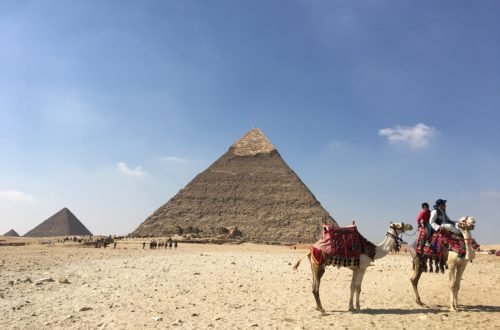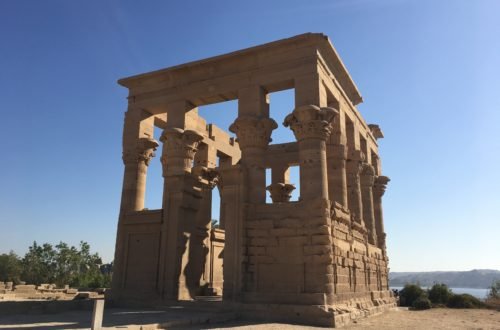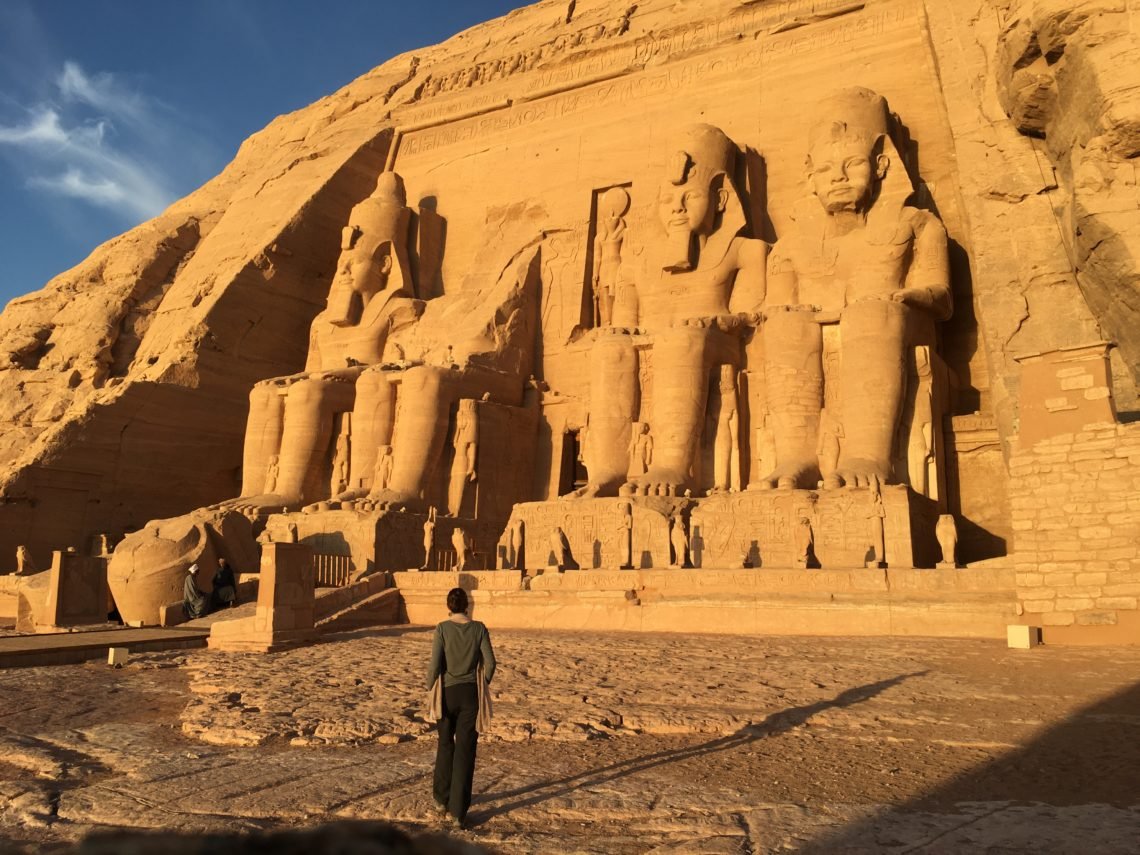
Farewell from Abu Simbel temple on Nasser Lake
Four seated monumental statues of pharaoh Ramesses II facing lake Nasser. You would already have guessed, I am looking at Abu Simbel temple. This is my last step before crossing the border into Sudan. One last time, Egypt will fill my eyes with wonders.
Abu Simbel site, it is the colossal temples of Ramesses II (1279-1231 BC) and of his wife Nefertari. But also a quiet Nubian town on Nasser lake and the departing point to Wadi Halfa in nearby Sudan. The high dam of Aswan flooded large areas of Nubia in Southern Egypt and Northern Sudan in the 1960s. Unesco saved several major archaeological sites such as the Abu Simbel and Philae temples.
Last great archaeological site during my trip in Egypt, Abu Simbel is also the most southern town on the road to Sudan via Wadi Halfa. It is strange to see heavy sculpted rocks thousands of years old and a landscape which was artificially created by lake Nasser just about half a century ago. The flooding had a massive impact on the local environment and I can not help wondering about what lies below the waters of the lake.
/ Geological pyramids of the Lybian desert
/ Sunset and light show at Abu Simbel temple
/ Incredible hospitality at the Eskaleh Nubian Lodge
/ Second encounter with Abu Simbel at sunrise
/ Colossus outside and inside Abu Simbel temples
/ Crossing Nasser lake to Wadi Halfa in Sudan
/ Related: Abu Simbel, Nubia, Egypt, Unesco, Nasser Lake
/ Inspiration:
Ramses – The Son of Light (by Christian Jacq, 1995)
The Mummy (film by Stephen Sommers, 1999)
Rome (series by Bruno Heller, 2005-2007)
Geological pyramids of the Lybian desert
These are my last 24 hours on Egyptian soil. Sunrise is just upon Aswan when I take the first ferry of the day to leave Elephantine island and get on the East bank. Children wearing the school uniform are waiting for the boat as well.
Their level of English is as good as my notions of Arabic, which makes our conversation quite limited. Instead we use hands and smiles to understand each others. As usual, Nubians are very friendly and welcoming.
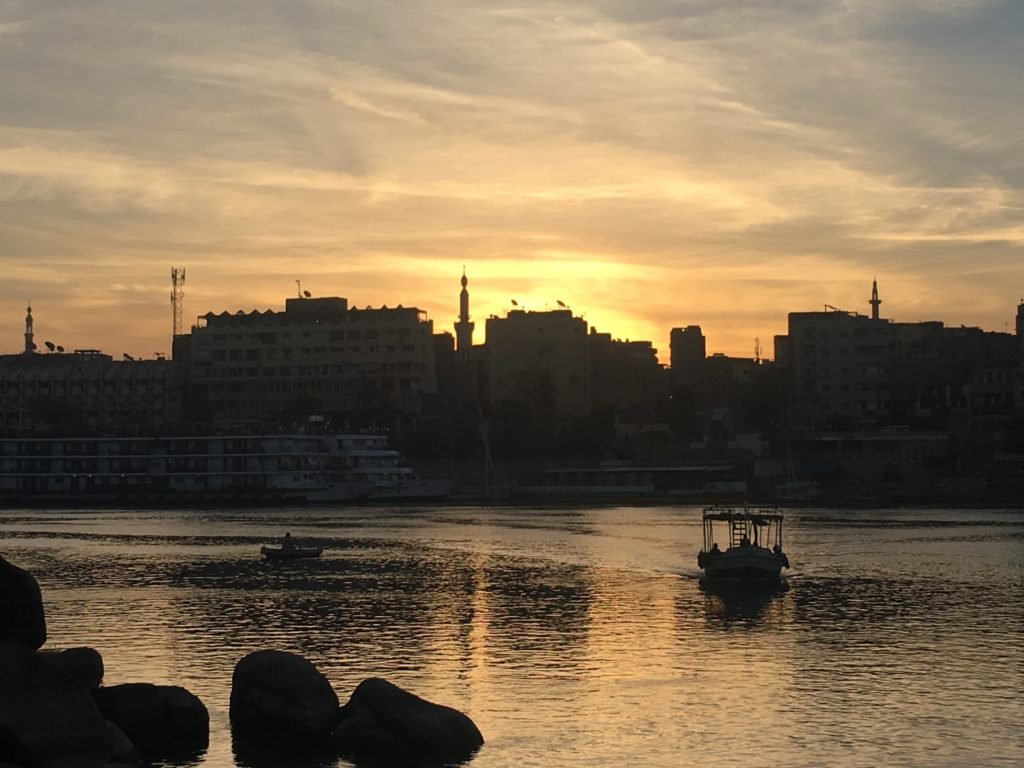
I reach the bus station and negotiate my ticket (Travel tips for the journey from Aswan to Wadi Halfa available here). Driving across the Lybian desert, I shall reach Abu Simbel by midday and spend the night in town.
As we leave Aswan, we pass on the old dam, I look down at the city and the dry Nile on my right hand side. Turning my head to the left, the river is packed with water. Only a narrow road strip separates the two sides. A few miles upstream, the high dam supplies power to the entire region and marks the start of lake Nasser.
The road is monotonous. A flat sandy landscape stretches for miles. We pass a massive plant and stop in the middle of – seemingly – nowhere to disembark a few workers. After two hours, the landscape changes and dark rocky formations appear.
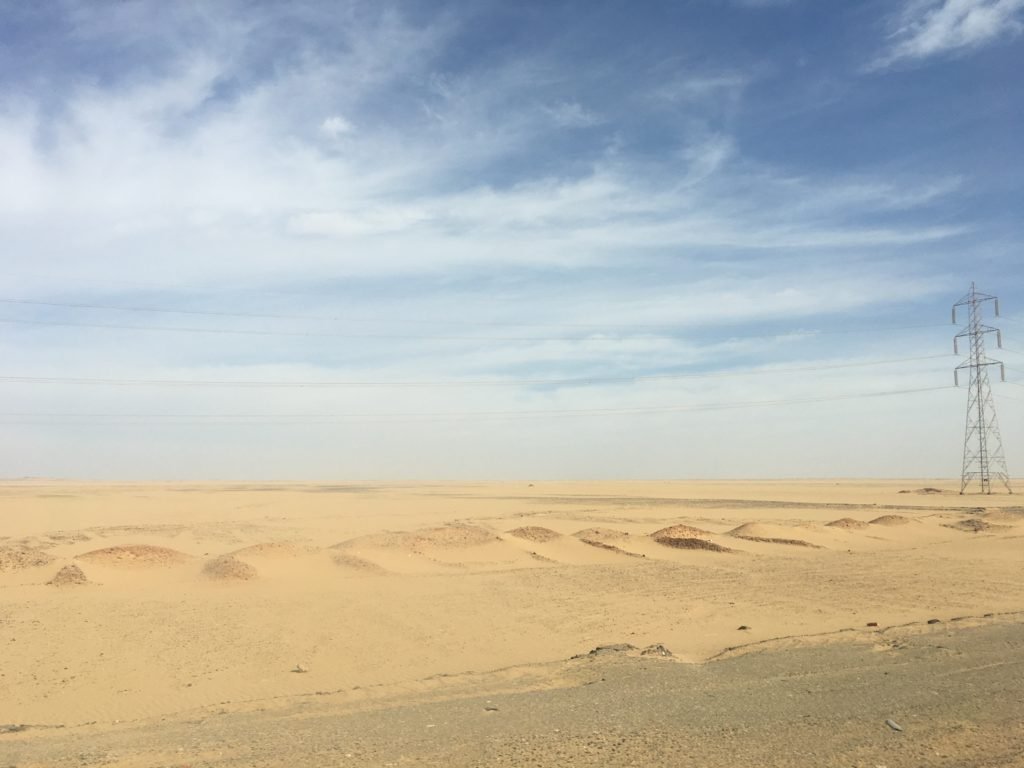
To me, they look just like natural pyramids. At this very moment, it just comes as obvious that the people who came here centuries ago found inspiration for the pyramids. What would be more logical? If these geological formations are the work of gods, then men would imitate such creations for their divine rulers, the pharaohs.
And as often seen in civilizations, pyramids started “small” (article about Meore pyramids in Sudan to come soon) and evolved to become gigantic in Giza. After which, the tendency reversed and royalties had their last resting place hidden, generally into the ground, like in the Theban necropolis near modern Luxor.
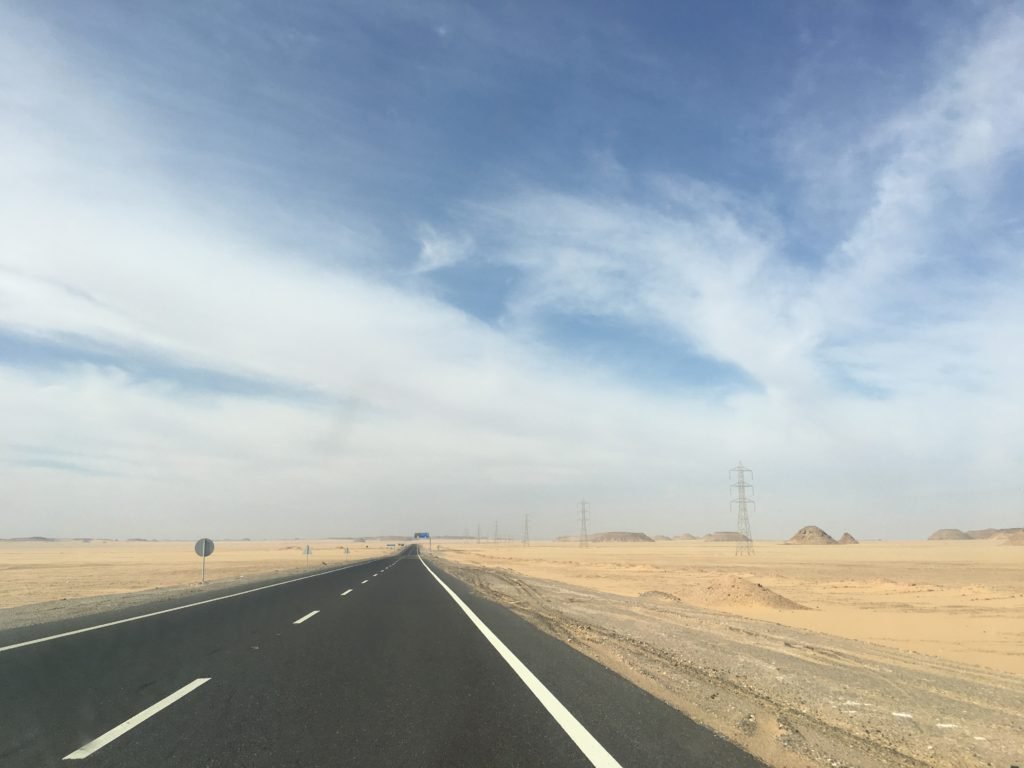
Sunset and light show at Abu Simbel temple
I am still reflecting on the possible origins of the pyramids when we pass a small modern settlement in the desert. Someone would tell me we just landed on some planet in the Star Wars world, I think I would believe it. The city stands on the sand like a mushrooms colony on a moss bed.
We pass by a canal, the road is now getting close to Nasser lake again. After the emptiness of the desert ride, traffic slightly increases as we get closer to Abu Simbel. Flowers greet us on the side of the road, I have reached destination.
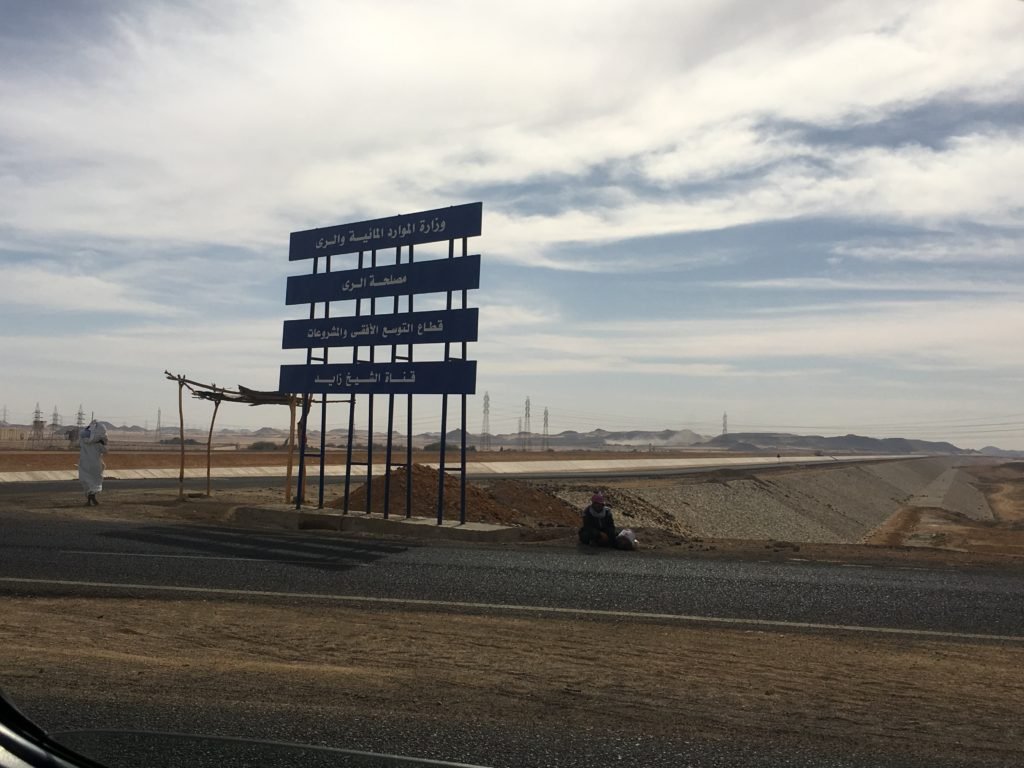
My initial plan was to get to bed early and go to the temples for the opening before sunrise. But I finally decide to go this very evening and to attend the light show. The sun is already behind the horizon when I enter the Abu Simbel complex. The statues are impressive but already fading in the weak light of dusk.
As expected, the site is full with tourists who will attend the show tonight. Mainly a huge group of Japanese and a few European couples. As a result, the show is in Japanese! I quickly get rid of the small translator and earplugs. The comments are fine but not overwhelmingly interesting, especially if you have done your homework before coming.
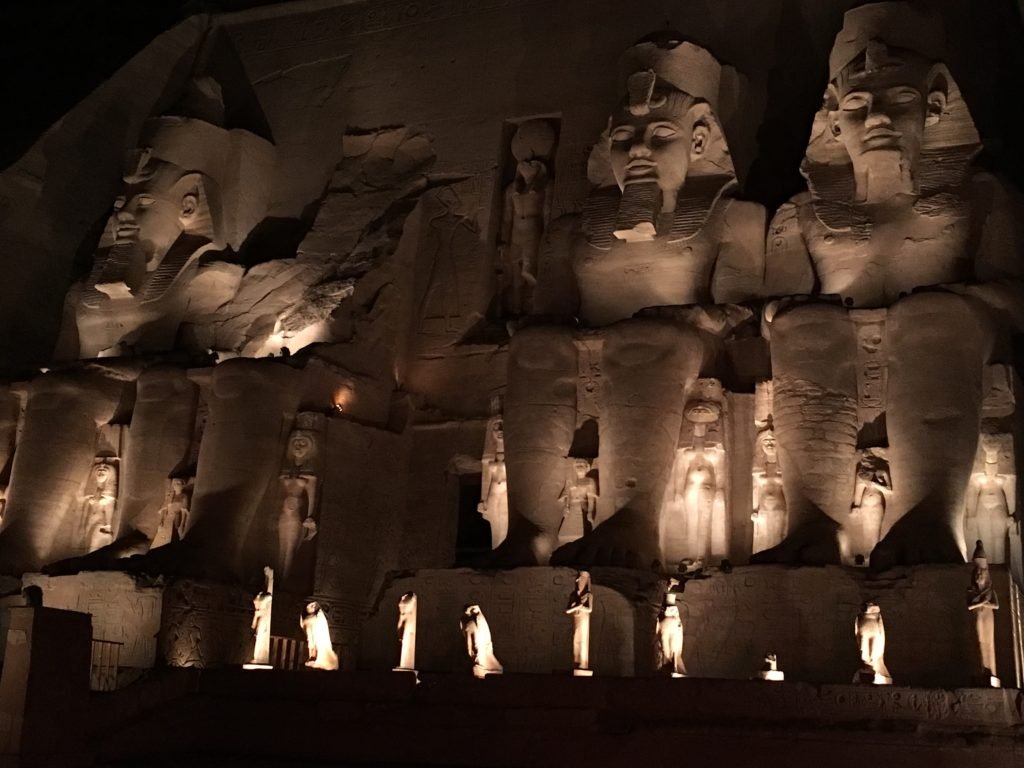
Both Ramesses and Nefertari temples shine in white or red colours. The light show definitely enhances the statues and detailed carvings on the temple facades. Projection of a short film explaining the Unesco rescue work and the pharaoh’s life bring some history content.
From time to time, I raise my eyes to the black sky and stare at the amazing shining stars vault. The air is so pure and not a cloud to impair the visibility. Drums resonate on the hills as the shows goes on. I did not attend any other light show during my Egyptian trip. Tonight, I certainly do not regret my choice to come. After all, this is Abu Simbel!
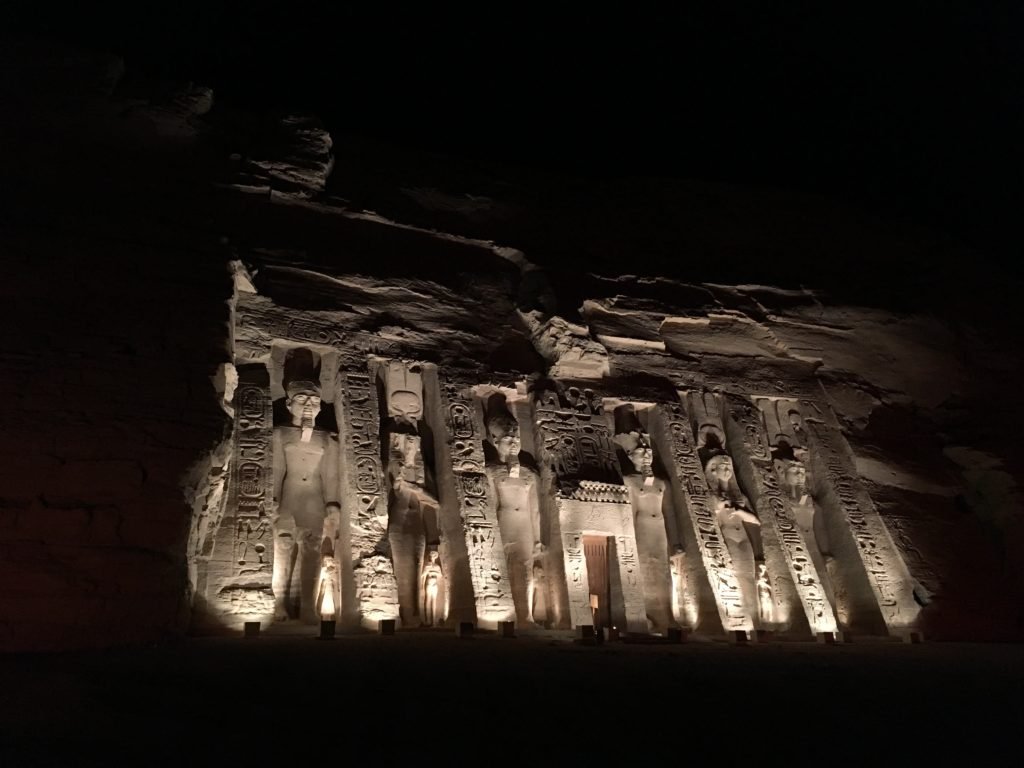
Incredible hospitality at the Eskaleh Nubian Lodge
Accommodation options are relatively limited in Abu Simbel, compared to the rest of Egypt. A handful of places pop up on the web, including “hostels” with terrible travel reviews. If you think about it, tourists come only to see the temples. The official departure point to Wadi Halfa is in Aswan and there is apparently “nothing else” to see around.
I ask local people about other things to do around since I have a full afternoon before the light show. Maybe some desert trekking… safari… scuba diving… or some minor historical site to visit I suggest. Everyone is categoric. No tomb, no church, no temple or ruins known in the area.
If there was anything, it is likely under Nasser lake waters or still buried in the sands of the desert. No activities on the lake and for a good reason – beware of the crocodiles! As for the desert, I just spent half a day crossing it and will continue to do so in Sudan. So be it, it will be a relaxing afternoon in Nubia.
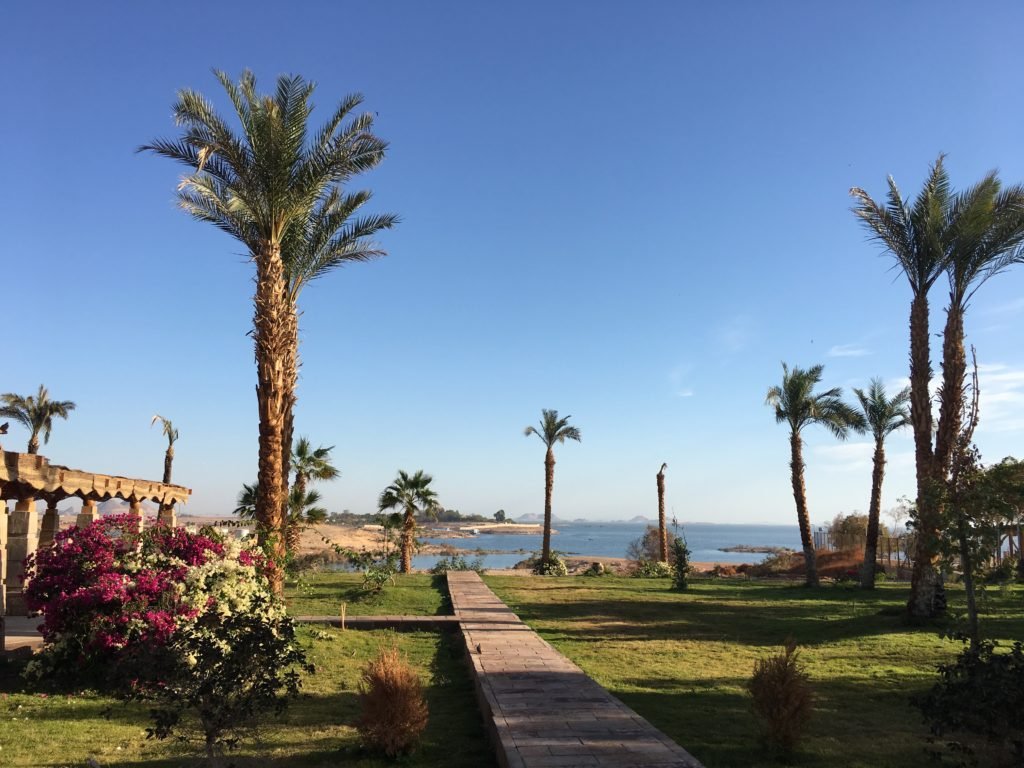
Back to the accommodation topic, there is one place that particularly touched my heart: the Eskaleh Nubian Ecolodge. Even though I could not spend the night because of a booking confusion, I had a delicious dinner back from the light show and a nice chat with the owner Fikry and his son.
He explains to me that his family created Eskaleh to promote the Nubian culture. The traditional construction uses natural material such as mud bricks and straw. It keeps the inside temperature cool during the hot season. The architecture and colours are soft and perfectly integrated into the environment.
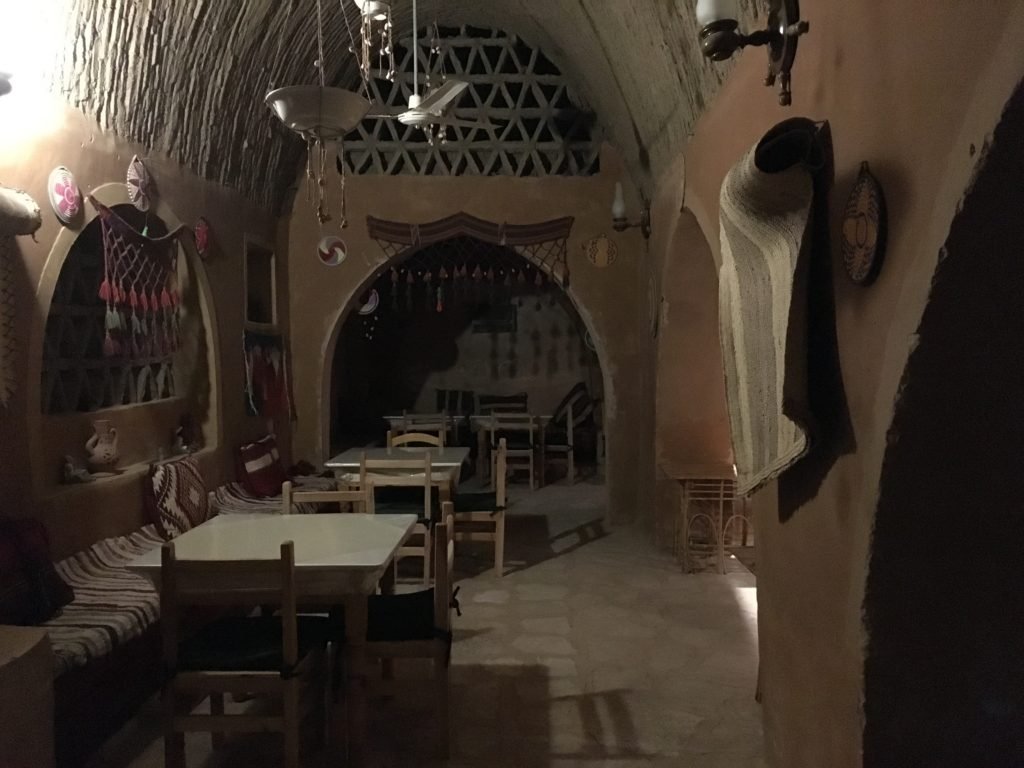
I recognize the typical Nubian vaulted ceiling in the dining room and the library. Traditional plants grow in the courtyard and the terrace looks over Nasser lake. Later on, I inquire about the origin and meaning of the name Eskaleh. I learn it is related to a historical Nubian water mill.
The lodge has a limited capacity which makes it very pleasant, like visiting friends or family. This is really a place I wish to come back to, this time for a proper stay. Another nice discovery in Nubia. I finish the delicious basbousa (semolina cake) under the stars and in the lights of candles. I am definitely in love with Nubia!
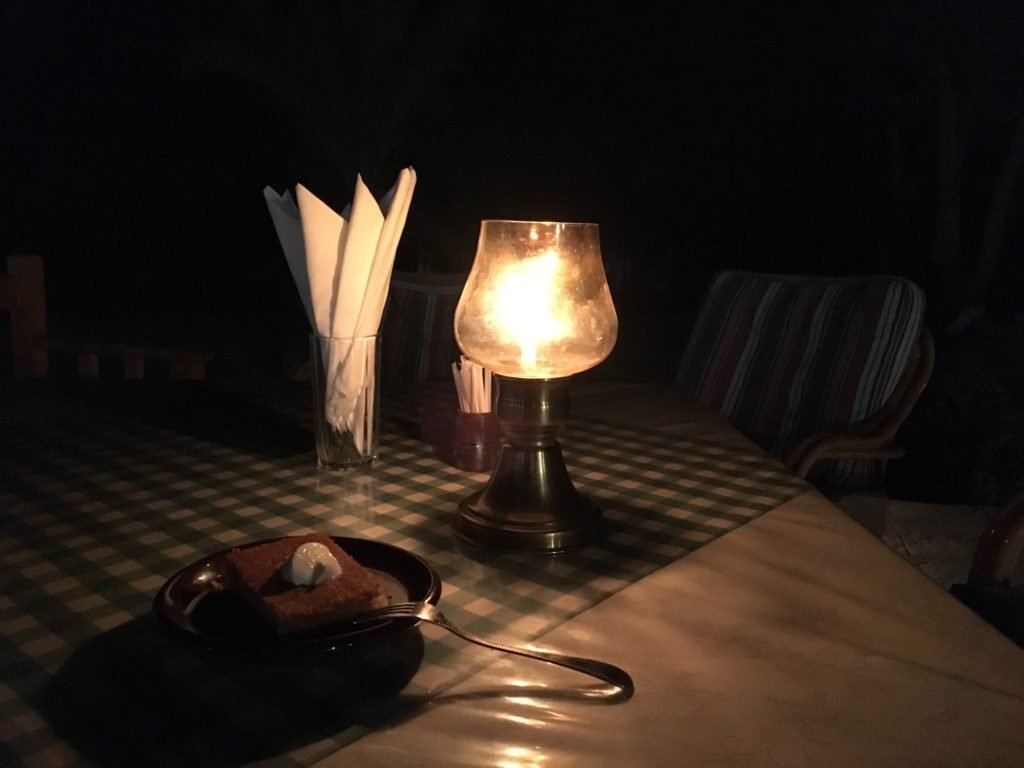
Second encounter with Abu Simbel at sunrise
Another short night sleep and I get out on the street while the muezzin starts calling for the morning prayer. A red solar disk is just pointing from behind the mountains on the East. The sky and the waters of lake Nasser turn progressively from grey into gold.
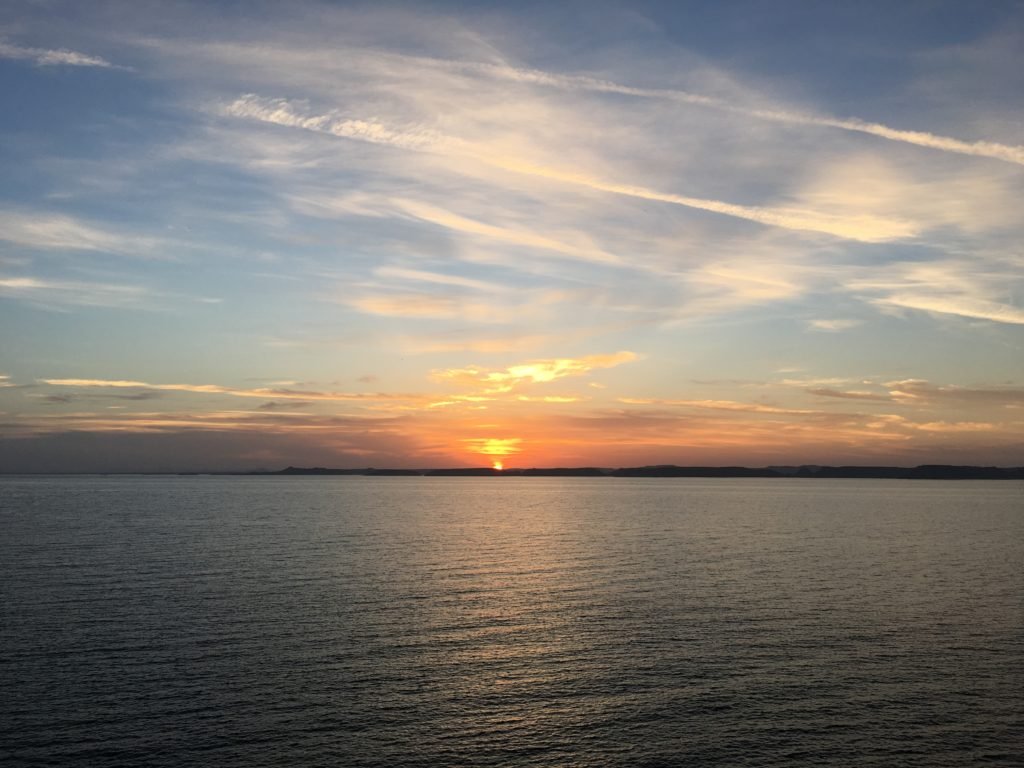
I meet the Japanese group and a French couple from yesterday light show. The group is on a schedule and stays only a few minutes to take the souvenir pictures. In no time, the complex is empty.
The sunlight on the Great Temple facade of Abu Simbel keeps changing. I have all liberty to admire the statues and carvings. The dimensions are impressive: 108 feet height, 124 feet width and 200 feet depth for Ramesses II temple. The colossal statues are 67 feet high.
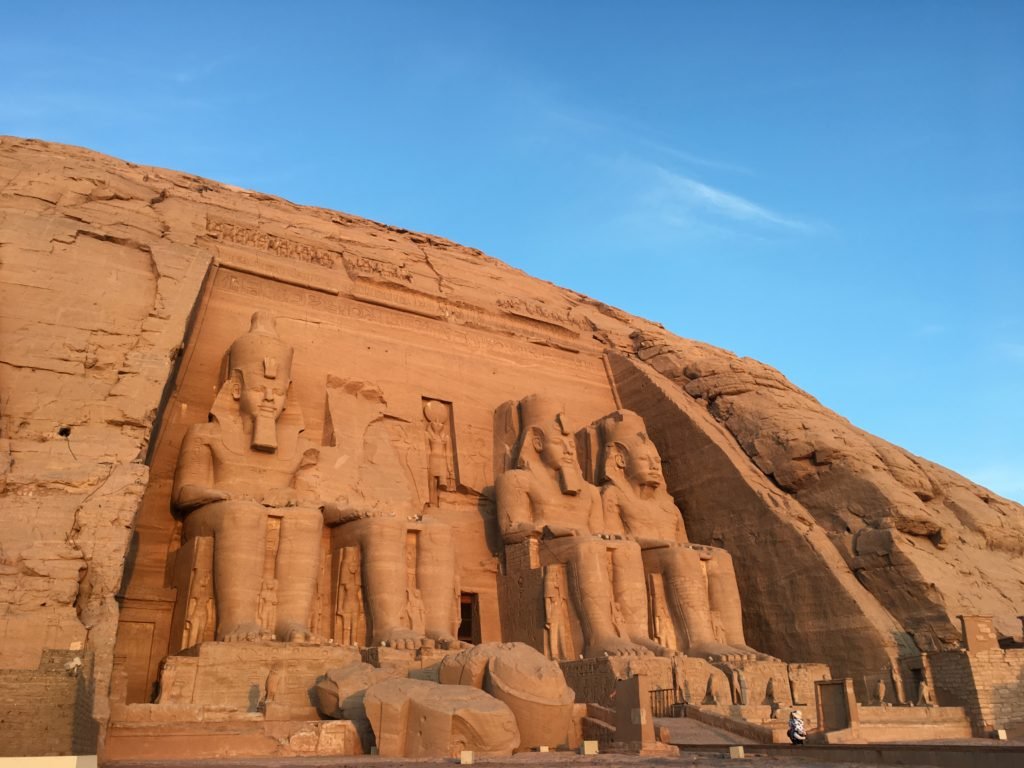
The only sound is the wind blowing in the trees and the birds singing above my head. I am all alone with only the two guides at the temple entrance who pay no special attention to me. Suddenly, the whole temple becomes gold under the warm sun rays. Another magical moment!
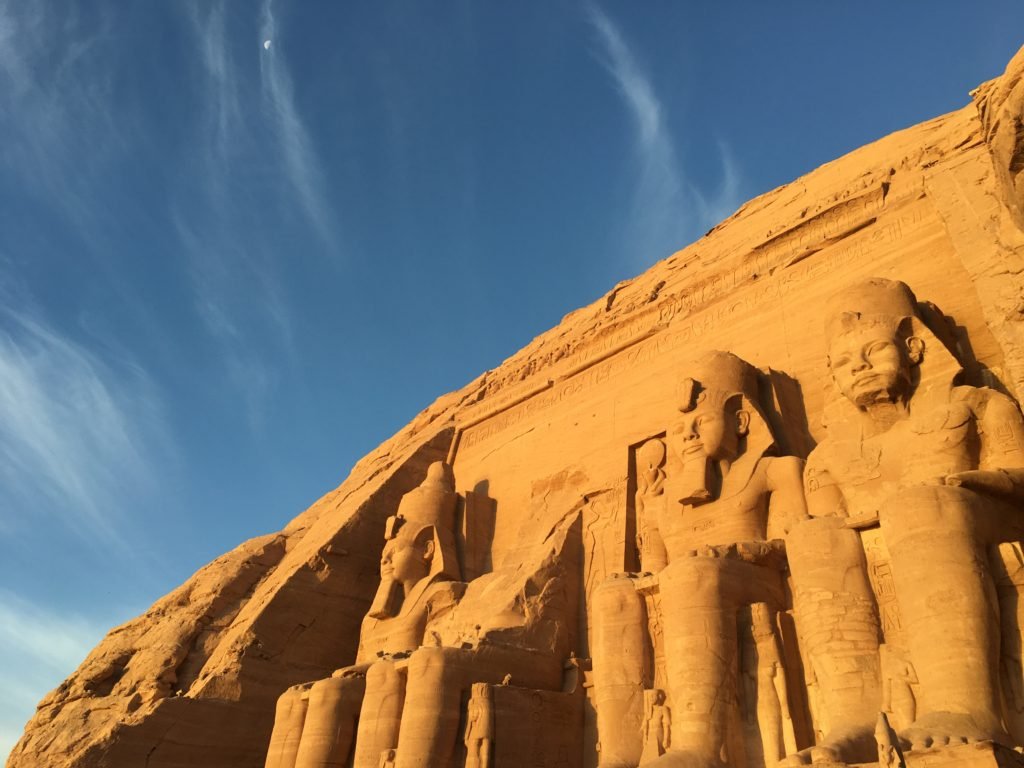
The Small Temple on the right was dedicated to Nefertari and the goddess Hathor. The beauty and elegance of the carvings largely compensate its smaller dimensions. Nevertheless, the monumental statues on the facades are over 30 feet high.
Both temples are about 3.000 years old and look eternal. Since 1968, however, they stand 65 meters higher and 200 meters away from their original location. The Unesco rescue program to save the monuments of Nubia took several years and costed millions of dollars. Abu Simbel is one of the sites covered by the rescue program. It took 4 years to save Abu Simbel. The “now or never” emergency call got answered.
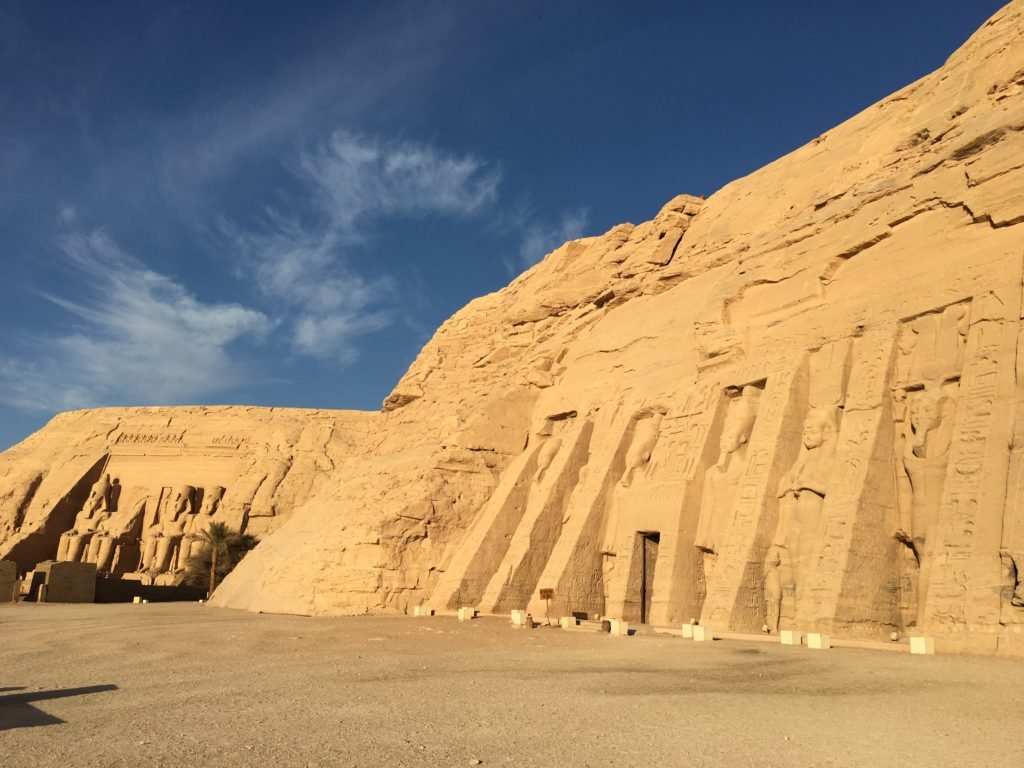
After cutting the temples by blocks, all pieces were transported to the higher location. The blocks were assembled again to rebuild the temples identical to the originals. Fake hills were even built to host the rescued temples and recreate the original environment. The final result is quite convincing.
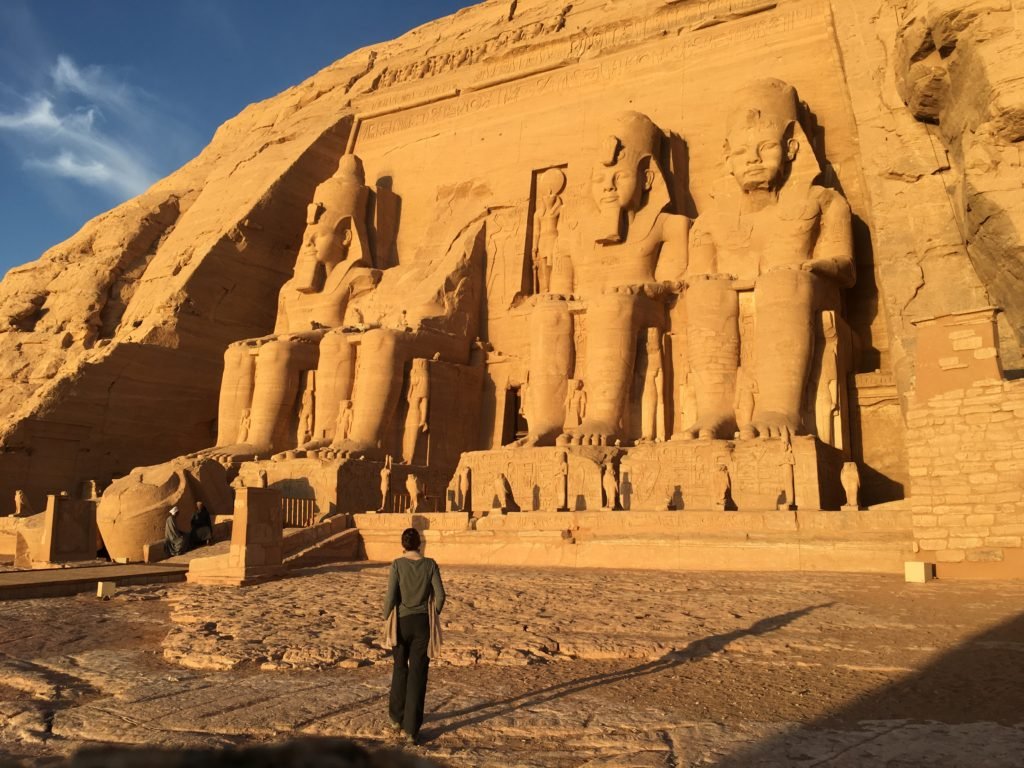
Colossus outside and inside Abu Simbel temples
Abu Simbel is one of the rare sites for which I did not do any special homework or research. I wanted to keep some elements of surprise. Of course, I was familiar with the outside appearance of the temples. But I did not have the slightest idea about the inside.
Imagine you are standing in front of the Great Temple. Three colossal statues of Ramsesses II watch over you while the collapsed pieces of the fourth lay on the ground. The sun at my back, I walk towards the great entrance door and salute the many smaller statues standing on the facade.
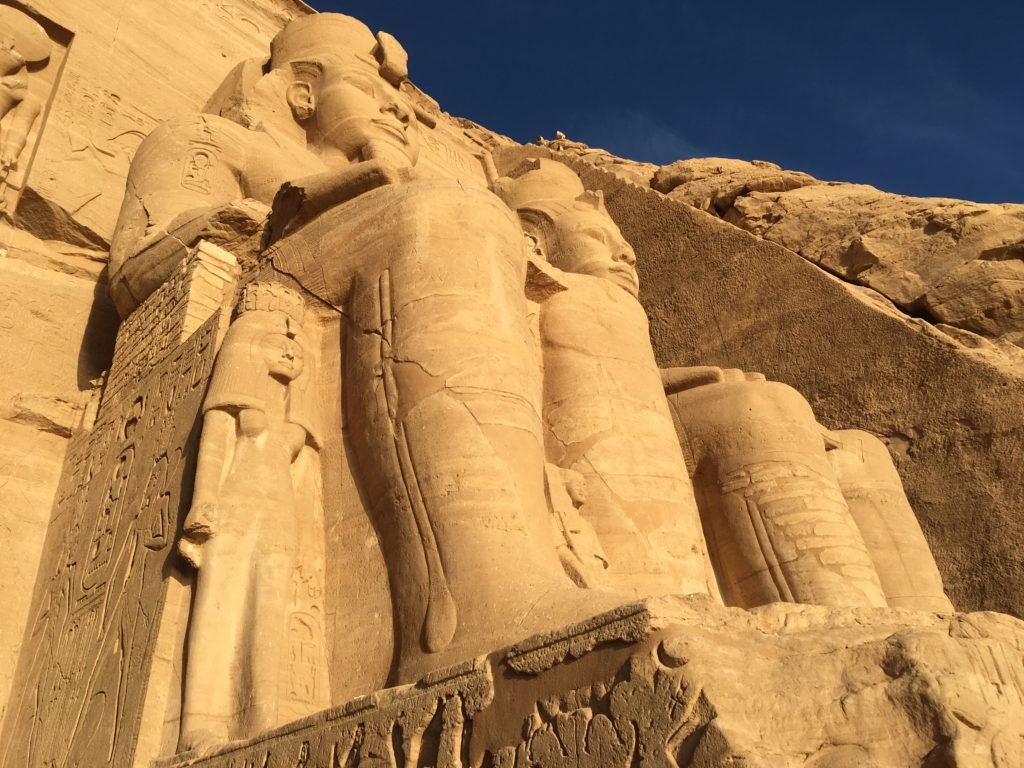
It is dark inside. Only the central corridor is highlighted. The rising sun projects my huge shadow on the paved ground floor. I feel a presence inside the temple, I am not alone. My eyes get used to the obscurity and I see two rows of monumental pillars which are in reality Osirian statues of Ramesses II. Believe it or not, I truly felt a kind of presence in this room despite being the only human here.

Carvings depicting the military victories of the pharaoh, including the battle of Kadesh, cover the walls. In the deepest vault, four seated statues representing Ramesses II, Amun-Ra (creation god), Ra-Horakhty (sun god) and Ptah (underworld god) face sunrise. The sun kisses the two central sculptures. I stay a few minutes to capture the instant and engrave it in my memory. It is a beautiful and touching moment.
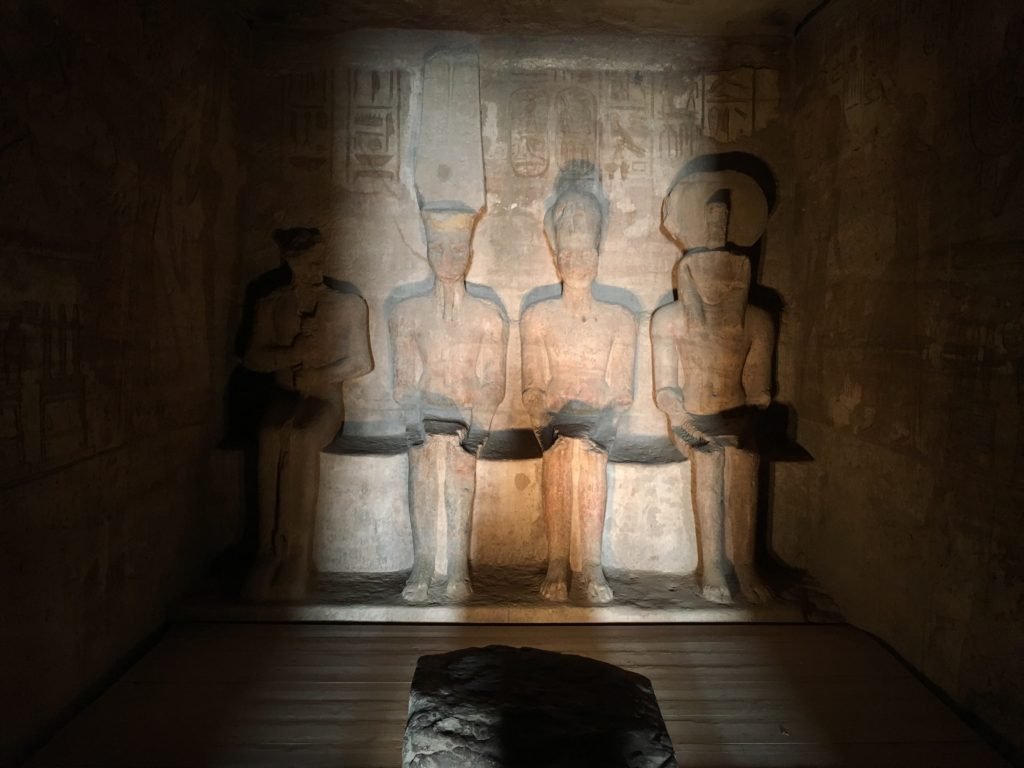
When entering inside Nefertari temple, I cannot help having the same feeling I had when visiting Queens valley after the Valley of the Kings. The main pillared room is much smaller than its male’s counterpart. On the other hand, the decoration is more elegant, definitely feminine!

Instead of massive Osirian effigies, refined face carvings ornate the pillars. No battle scenes on the walls but representations of the queen and various goddesses. A complete different atmosphere. I wish I had more time to study the temple. One hour on your own is great but not enough. The regular flow of tourists is now arriving and I have a long day ahead of me. I say my last goodbye and leave.
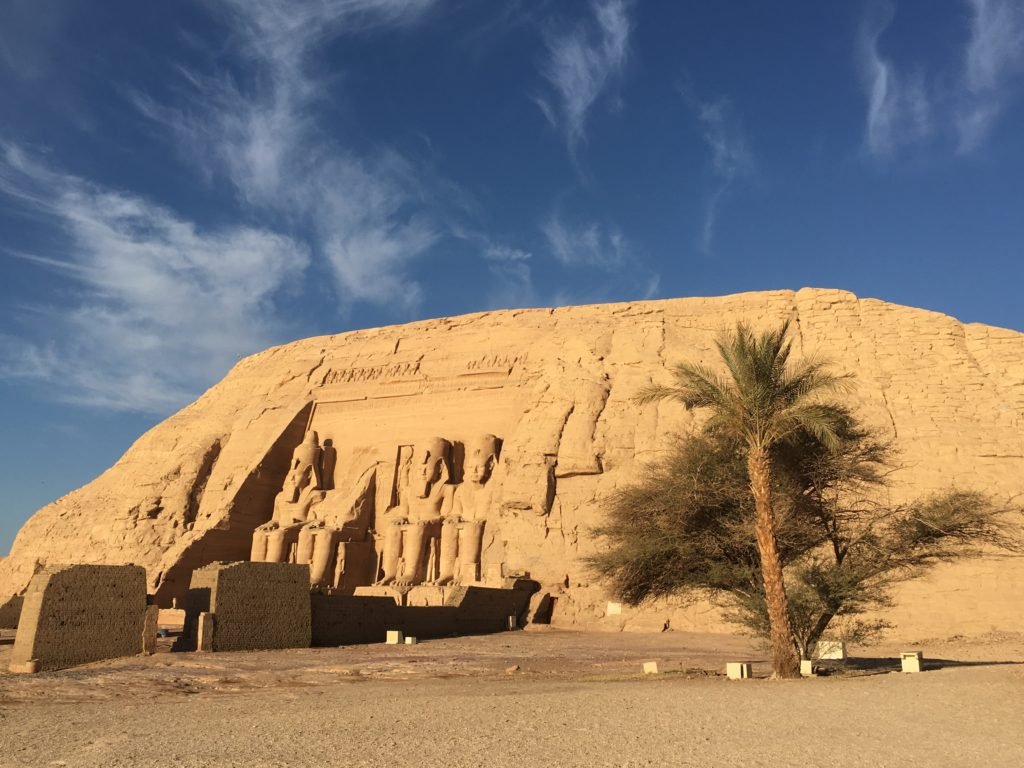
Crossing Nasser lake to Wadi Halfa in Sudan
This is it, in a few hours I will be in Sudan. Or at least, I hope! My last hours in Egypt are peaceful. It is time to move on but I am a bit sad. During this trip across Egypt from North to South, the deepest I went into the Lybian desert, the more I liked it. I wonder what Sudan has in store. Not too sure what to expect to be honest.
I leave my hotel and head for the ferry pier. It is just a short walk in the morning sun and the temperature is perfect. A small group of tourists just arrived from Aswan by bus and are waiting to embark. I meet the German couple from the Sudanese Consulate in Aswan and Britons from a small independant travel group. In total, I believe we are no more than 8 tourists to head to the border that day.
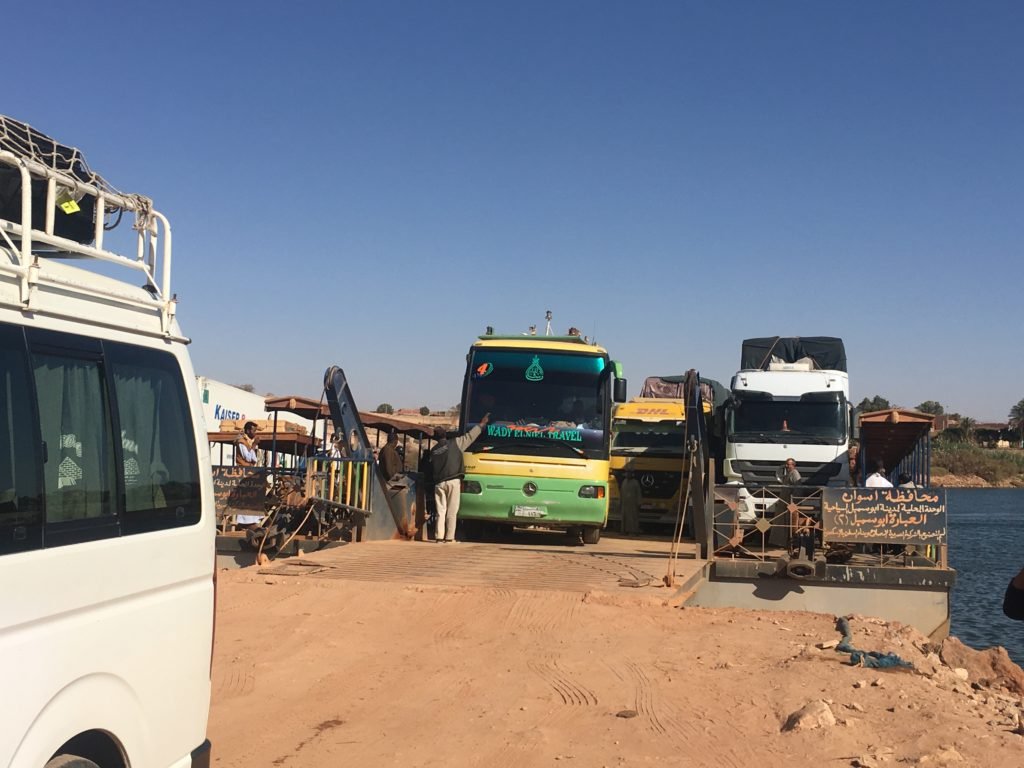
The ballet of trucks and other means of road transportation, including our bus, embark on the tiny ferries and start the crossing of lake Nasser. The shores are pristine and mineral. On the calm waters, the sun rays reflection shine like thousands of diamonds. After an hour or so, we reach land. Technically speaking, we are still on Egyptian soil.
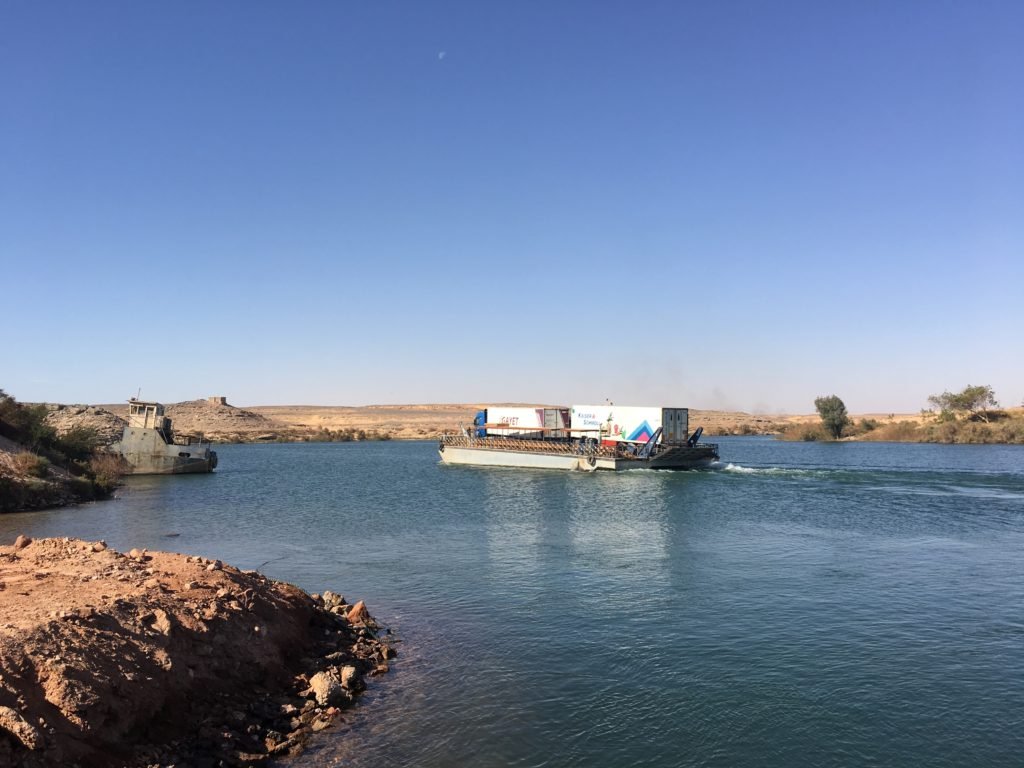
Is it my imagination running wild? It seems we are setting foot on a different country already. I share my thoughts with two other foreign travellers and our impressions all concord. The majority of travellers that day are Sudanese and Egyptians. For them, the trip is more of a routine. We (the foreigners) are slightly more excited…
After disembarking the bus on the red sand, we all get in again and head to the border post. Similar geological formations in the shape of brown pyramids spot the desert landscape. But I persist, the air is different, there is something else, hard to describe with words. This is Sudan.
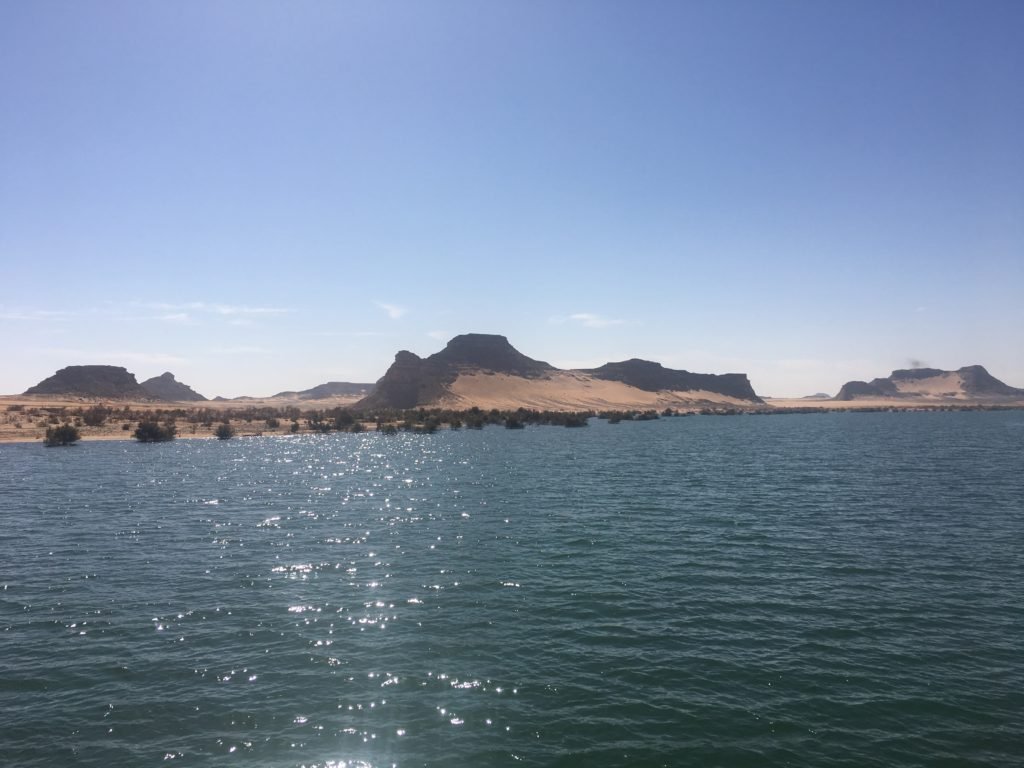
Nubia said farewell in an outstanding and unforgettable show. All the ingredients were here: amazing temples, incredible Nubian hospitality, fantastic environment and nice food. I made a point in stopping by Abu Simbel before heading to Sudan. My itinerary in public transportation was not really a straightforward one given the restrictions applied to tourists. But it worked out well and was certainly worth the effort.
I am now on my way to Sudan, continuing my travels in parallel times. On one hand I am going back in time, tracking the ancient civilization of Meroe which ruled before the famous Egyptian pharaohs. On the other hand, I am about to discover a discrete country of the 21st century. The majority of people know very little about Sudan which is definitely a travel destination out of the beaten tracks.
Want to know more about Abu Simbel? Here are a few links:
https://en.unesco.org/70years/abu_simbel_safeguarding_heritage
http://unesdoc.unesco.org/images/0006/000642/064240eo.pdf


